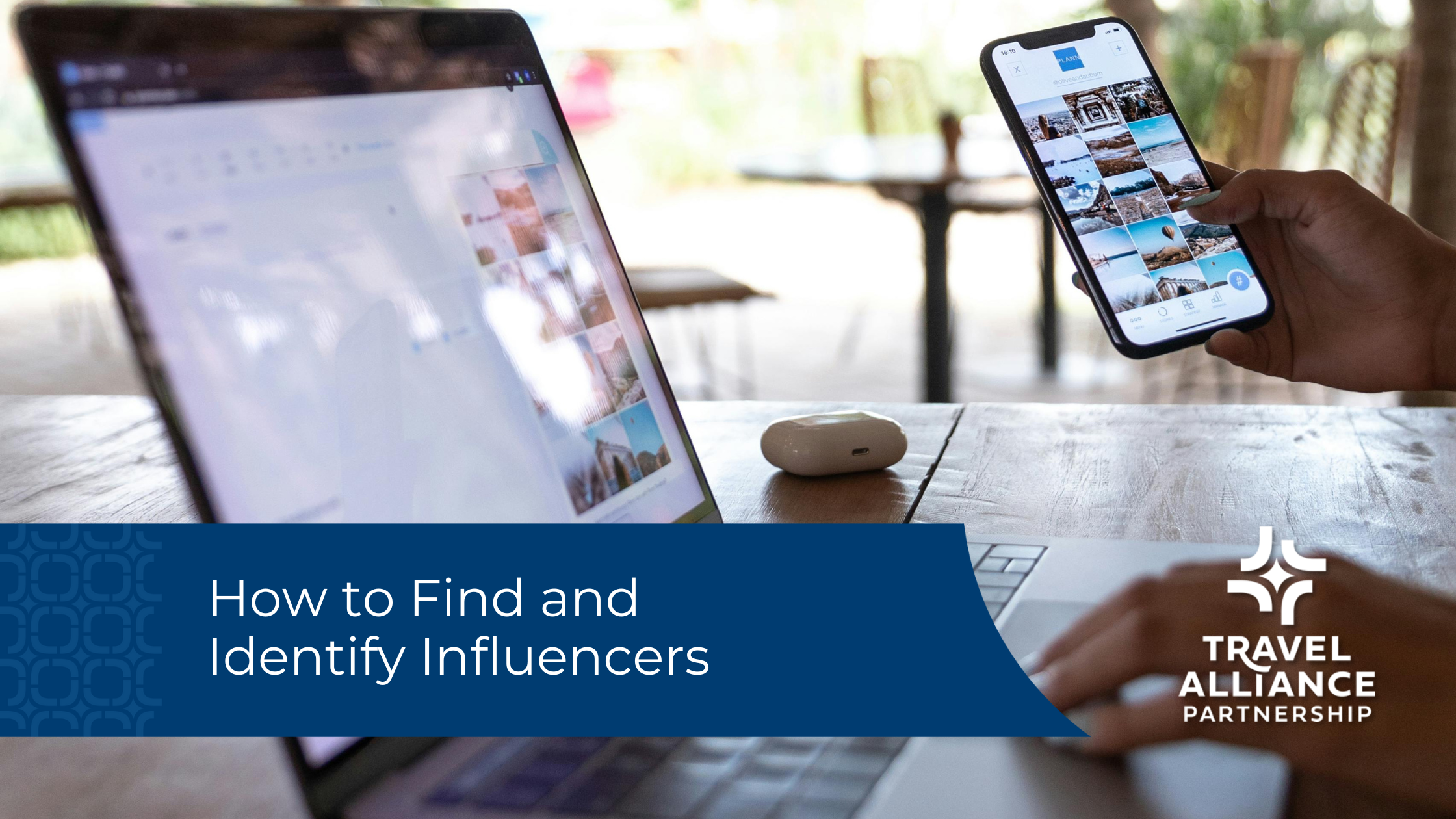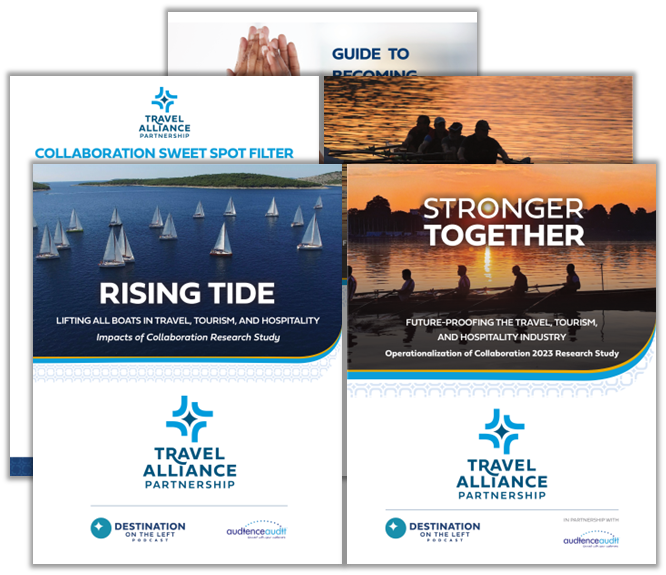How to Find and Identify Influencers
In today’s digital landscape, influencers play a pivotal role in shaping travel decisions and inspiring destination discovery. Whether you’re promoting a hidden gem of a small town, a unique attraction or a world-famous city, partnering with the right influencers can amplify your message and build authentic connections with your target audience. But with thousands of voices online, how do you find the ones that truly align with your brand or message while resonating with your target audience?

In this blog post, we’ll explore not only how to identify influencers, but also how to effectively discover and evaluate influencers to ensure meaningful, results-driven collaborations.
Shaping Your Ask
Before looking for potential partners, think about the ideal influencer campaign.
Your Reason
Determine why you want to work with an influencer. Perhaps the biggest reason: 69% of consumers are more likely to trust what an influencer says about your brand or destination than your own marketing or advertising. So, what do you want your audience to know or think about your brand? Identify a story line or various angles that would resonate with influencers and their audiences. For example, you may look to build awareness of a new product or offering, or to encourage folks to buy tickets to an upcoming event or exhibit. Sometimes, you are looking to get an outsider’s unique perspective on a destination or attraction.
Your Audience
Pull together relevant demographic and psychographic information about your target audience. Where do they live? What are their interests? What type of media do they consume, and what platforms are they on? You will then look for influencers who reach these individuals and most content that they are interested in.
Deliverables
Determine what types of deliverables you want out of the interaction. Do the stories you want to tell resonate better over photo or video? Next, consider how long of a shelf-life those stories have. Something that is quick and timely will perform well as ephemeral content. An evergreen offering works best as a reel or blog post. You may also consider receiving content to own and use in your own marketing – such as guest contributor copy, photos or videos to use on your website, or reels that you run advertising around.
Budget
Lastly, think about your budget for the engagement. How much are you able to pay a content creator? How much are you able to cover in other costs (travel, experiences, meals, etc.)? What is the value of any in-trade experiences (overnights, tickets, etc.)?
How to Find Influencers
Media Databases
There are many influencer databases or directories available to help you search for the right partnership, although they can be quite expensive. (Social Cat shares its recommendations here.) For a most cost-effective option, consider the organizations you already have memberships to, or media events you’ve attended in the past. For example, attending TravMedia’s International Media Marketplace grants you access to the event’s attendees for at least a year.
Search on the Platform
Open the social media platform you’re most interested in and search the top posts around a specific geography or topic. For example, searching for “Buffalo food” will likely result in Buffalo-based food influencers. Or searching for “wheelchair accessible travel” will pull up individuals posting about destinations that are accessible for wheelchair users. Search for popular and relevant hashtags to see who is using them in their posts.
Competitors
Look at similar destinations or attractions to your own on the social media platform you’re interested in. Who is tagging them? Who are they collaborating with? Are they sharing posts (or stories) from other users?
Your Own Audience
Look at your own followers on a platform. Local and regional influencers may already be following and tagging you. See who is doing the same for partners in your destination.
Search Online
Google or AI platforms can pull together lists of top influencers from aggregating websites and local news channels, reddit threads and more. There are even listicles of specific niches (i.e., “10 Inspiring Disability Influencers Making a Difference”) to help you get started.
Other Influencers
Many influencers work in “pods” to promote each other’s content. Once you find one influencer who is a good fit for your campaign, look through their list of followers and see who is commenting on their posts. This may send you down a rabbit hole of endless possibilities!
How to Vet Influencers
Audience
First and foremost, what does their audience look like? Quality is more important than quantity, but we do look at how many followers they have first. Then, what is the makeup of their followers? Based on a quick scroll through the list of followers, can you tell if they look legitimate? (Click on a few and see if they have real content, real photos and real followers.) Do they appear to be in your target audience? For example, if you’re looking to reach moms but most of the followers are outside of that stage of life, it may not be the best fit. You can (and should!) always ask an influencer to share stats and demographics about their followers to clear up any questions.
Engagement
More important than the audience is the engagement the influencer sees. How many reactions or comments do they receive on their posts? Does it seem appropriate for the number of followers they have? If they have thousands of followers but repeatedly get tens of comments, something may be off. Of those who engage with the content, are they adding meaningful, genuine comments? Seeing a slew of one-word comments or emojis gives off a red flag.
Note: While you might notice many comments from other influencers on a post, this engagement actually helps increase the post’s visibility to broader, non-influencer audiences.
Content
Scroll through the influencer’s feed and really look at the content. Do they post quality content? For example, are the photos high-quality and the videos well edited? Is the caption well written with enticing copy? Most importantly, do you see posts like the ones you want them to publish about your destination or product? Influencers’ audiences can sniff out if an engagement is inauthentic. If what you’re looking to promote doesn’t align with what they’re currently posting, it might be an easy “no” to the partnership.
Frequency
Social media is constantly changing its algorithms; one needs to post frequently to understand what is – and isn’t – working. If the influencer posts infrequently, or hasn’t posted in the last few months, they might not be actively “working” their account. Reach out to see if they are still taking partnerships.
Nothing beats personal interaction. Once you think someone may be a good fit for a partnership, or if you have a few questions that you would still like answered, schedule a call to discuss how they typically handle campaigns. A 15–30 minute call can give a great gut-check on whether the partnership will work out well.
Start the Conversation
You may cultivate a relationship on their platforms before reaching out. Interact with their content by liking or commenting on their posts to show support for what they’re doing. Make sure your comments are genuine and valuable, not repetitive or canned. This added engagement is good for their metrics, so it’s a win-win.
Then move the conversation off the platform. Although influencers spend a lot of time on their social channels, it’s best to reach out via email instead of a direct message. Just like you would pitch a traditional media member, make sure your email introduction is personalized to their content and interests. Reference something you saw on their feed that resonated with the campaign, or the type of content they typically post and how it fits into your destination.
Be up-front about what you are envisioning for the campaign. Do you want them to visit in-person, or are you looking to send them a product sample? What type of deliverables are you looking for, and what is the timeline for execution? Do you have a budget in mind or are you offering in-trade experiences?
Remember: influencers and content creators work with visuals. Help them picture what the destination or angle is – like rail biking along fall foliage or hiking among winter lights – by including links to websites or sample photos and videos.
The more details you provide in the beginning, the smoother the conversation will be.
If your organization is ready to harness the power of influencer marketing, here are some more resources that can help you get started. If you’d like an extra hand with the process, reach out to us – we would love to work together!
Related Posts
Marketing for Group Travel: Building Solid Relationships with Tour Operators
Group travel is a significant segment of the tourism market, and if you want to see those buses pulling up to the curb and filling…
From Assistant to Amplifier: Rethinking AI for Tourism Marketers
After attending MAICON, a Marketing AI conference hosted by SmarterX, one message came through loud and clear: AI isn’t replacing marketers—it’s making our work sharper,…
